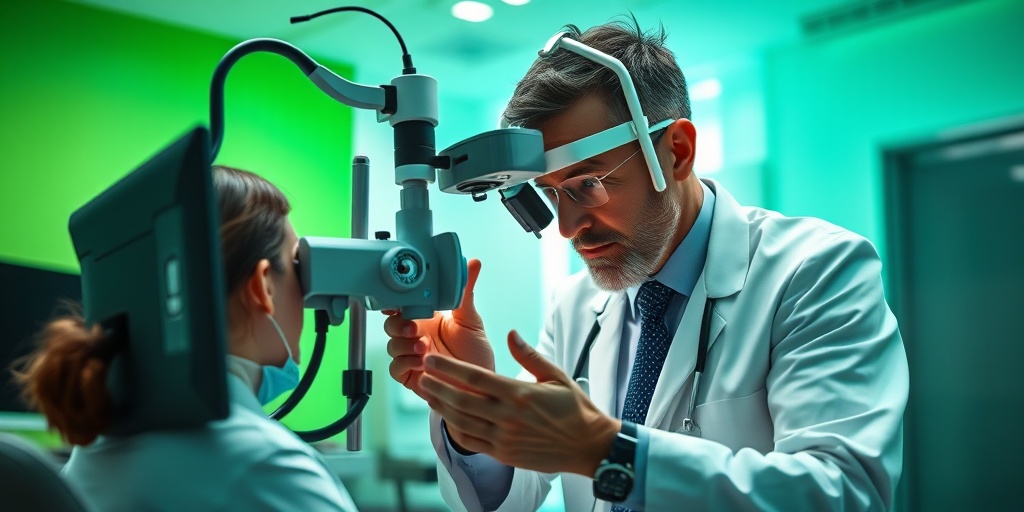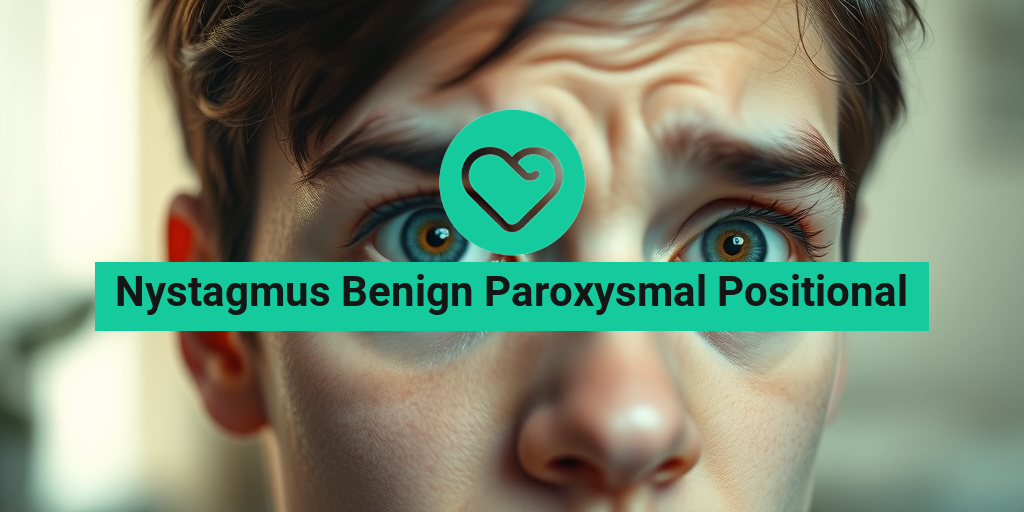What Is Nystagmus?
Nystagmus is a condition characterized by involuntary eye movements, which can lead to a range of visual disturbances. These movements can be horizontal, vertical, or rotary, and they often occur in repetitive patterns. While nystagmus can be a standalone condition, it is frequently associated with other medical issues, including benign paroxysmal positional vertigo (BPPV).
In the context of benign paroxysmal positional vertigo, nystagmus is particularly significant. BPPV is a common vestibular disorder that causes brief episodes of vertigo when the head is moved in certain positions. The connection between nystagmus and BPPV is crucial for understanding how these conditions interact and affect individuals.
Types of Nystagmus
Nystagmus can be classified into several types, including:
- Congenital Nystagmus: Present at birth or develops in early childhood.
- Acquired Nystagmus: Develops later in life due to various factors, such as neurological disorders, medications, or inner ear problems.
- Positional Nystagmus: Often associated with changes in head position, commonly seen in BPPV.
Understanding the type of nystagmus is essential for determining the appropriate treatment and management strategies. If you suspect you have nystagmus, consulting a healthcare professional is crucial for an accurate diagnosis.
Nystagmus Symptoms
The symptoms of nystagmus can vary widely depending on the underlying cause and the type of nystagmus present. However, some common symptoms include:
- Involuntary Eye Movements: The most noticeable symptom, which can be horizontal, vertical, or rotary.
- Blurred Vision: Many individuals experience difficulty focusing on objects due to the rapid eye movements.
- Balance Issues: Nystagmus can affect balance and coordination, leading to dizziness or vertigo.
- Visual Disturbances: Some may report seeing images that appear to jump or sway.
Specific Symptoms Related to Benign Paroxysmal Positional Vertigo
When nystagmus is associated with benign paroxysmal positional vertigo, additional symptoms may arise:
- Episodes of Vertigo: Sudden sensations of spinning or dizziness, often triggered by specific head movements.
- Nausea: Many individuals experience nausea during vertiginous episodes.
- Loss of Balance: Difficulty maintaining balance, especially when changing positions.
It’s important to note that not everyone with BPPV will experience nystagmus. In some cases, individuals may have benign paroxysmal positional vertigo without nystagmus, which can complicate diagnosis and treatment.
When to Seek Medical Attention
If you experience symptoms of nystagmus or vertigo, it is essential to seek medical attention. A healthcare professional can conduct a thorough evaluation to determine the underlying cause and recommend appropriate treatment options. Early intervention can significantly improve outcomes and quality of life.
For more information on nystagmus and related conditions, consider visiting Yesil Health AI, a valuable resource for evidence-based health answers. They provide comprehensive insights into various health topics, including nystagmus and benign paroxysmal positional vertigo.
In conclusion, understanding nystagmus and its symptoms is vital for anyone experiencing visual disturbances or balance issues. By recognizing the signs and seeking appropriate care, individuals can manage their symptoms effectively and improve their overall well-being. 🌟

Nystagmus Causes
Nystagmus is a condition characterized by involuntary eye movements, which can lead to difficulties with vision and balance. Understanding the causes of Nystagmus Benign Paroxysmal Positional is crucial for effective management and treatment. Here, we will explore the various factors that can contribute to this condition.
1. Inner Ear Disorders
One of the most common causes of nystagmus is related to inner ear disorders. The inner ear plays a vital role in maintaining balance and spatial orientation. Conditions such as Benign Paroxysmal Positional Vertigo (BPPV) can lead to episodes of vertigo and nystagmus. In BPPV, tiny calcium crystals in the inner ear become dislodged, causing abnormal signals to be sent to the brain.
2. Neurological Conditions
Neurological disorders can also lead to nystagmus. Conditions such as multiple sclerosis, stroke, or traumatic brain injury can affect the areas of the brain responsible for eye movement control. These conditions may result in persistent or intermittent nystagmus, impacting a person’s ability to focus and maintain balance.
3. Medications and Substance Use
Certain medications and substances can induce nystagmus as a side effect. For example, sedatives, anti-seizure medications, and alcohol can disrupt the normal functioning of the vestibular system, leading to involuntary eye movements. If you suspect that your medication may be causing nystagmus, consult your healthcare provider for alternatives.
4. Genetic Factors
In some cases, nystagmus can be hereditary. Genetic factors may predispose individuals to develop this condition, often manifesting in childhood. If there is a family history of nystagmus or related eye disorders, it may be beneficial to discuss this with an eye care professional.
5. Other Medical Conditions
Various medical conditions can also contribute to the development of nystagmus. These include:
- Congenital Nystagmus: Present at birth, often associated with other visual impairments.
- Retinal Disorders: Conditions affecting the retina, such as retinitis pigmentosa, can lead to nystagmus.
- Metabolic Disorders: Conditions like thyroid disease can also impact eye movement.
Nystagmus Diagnosis
Diagnosing nystagmus involves a comprehensive evaluation by a healthcare professional. Early diagnosis is essential for effective management of Nystagmus Benign Paroxysmal Positional and related conditions. Here’s what you can expect during the diagnostic process.
1. Medical History Review
The first step in diagnosing nystagmus is a thorough review of your medical history. Your doctor will ask about:
- Symptoms you are experiencing, including the frequency and duration of eye movements.
- Any previous medical conditions or family history of eye disorders.
- Medications you are currently taking or have taken in the past.
2. Physical Examination
A physical examination will follow, focusing on your eyes and neurological function. The doctor may assess:
- Eye movements and coordination.
- Balance and coordination tests.
- Vision tests to evaluate how well you can see.
3. Specialized Tests
In some cases, specialized tests may be necessary to confirm the diagnosis of nystagmus. These tests can include:
- Electronystagmography (ENG): This test measures the electrical activity of the eyes and can help identify the type of nystagmus.
- Videonystagmography (VNG): Similar to ENG, this test uses video to track eye movements and assess balance.
- Imaging Studies: MRI or CT scans may be ordered to rule out any underlying neurological conditions.
4. Referral to Specialists
Depending on the findings, your primary care physician may refer you to an ophthalmologist or a neurologist for further evaluation and management. These specialists can provide targeted treatment options based on the underlying cause of your nystagmus.
Understanding the causes and diagnosis of nystagmus is essential for effective management. If you or someone you know is experiencing symptoms of nystagmus, seeking medical advice is crucial for proper evaluation and treatment. 🩺👁️

Nystagmus Treatment Options
Nystagmus, particularly benign paroxysmal positional nystagmus (BPPN), can be a challenging condition to manage. It involves involuntary eye movements that can lead to dizziness and balance issues. Fortunately, there are several treatment options available that can help alleviate symptoms and improve quality of life.
Medical Treatments
When it comes to treating nystagmus, medical interventions can be quite effective. Here are some common options:
- Vestibular Rehabilitation Therapy (VRT): This specialized form of physical therapy focuses on improving balance and reducing dizziness. A trained therapist will guide patients through exercises designed to help the brain adapt to the abnormal eye movements.
- Medications: Certain medications, such as antihistamines or anti-anxiety drugs, may be prescribed to help manage symptoms. However, these are typically used on a short-term basis due to potential side effects.
- Surgery: In severe cases, surgical options may be considered. Procedures like muscle surgery can help reposition the eye muscles to reduce nystagmus. This is usually a last resort when other treatments have failed.
Alternative Therapies
In addition to conventional treatments, some patients find relief through alternative therapies. While these methods may not be scientifically proven, they can provide comfort and support:
- Acupuncture: This ancient practice may help alleviate symptoms by promoting relaxation and improving overall well-being.
- Chiropractic Care: Some individuals report improvements in their symptoms after receiving chiropractic adjustments, particularly if their nystagmus is related to neck or spine issues.
Understanding the Role of Lifestyle Changes
Making certain lifestyle adjustments can also play a significant role in managing nystagmus:
- Avoiding Triggers: Identifying and avoiding specific triggers, such as rapid head movements or certain visual stimuli, can help reduce episodes of nystagmus.
- Stress Management: Stress can exacerbate symptoms, so incorporating relaxation techniques such as yoga or meditation may be beneficial.
- Regular Exercise: Engaging in regular physical activity can improve overall balance and coordination, which may help mitigate the effects of nystagmus.
Nystagmus Home Remedies
For those seeking natural ways to manage benign paroxysmal positional nystagmus, several home remedies may provide relief. While these remedies are not substitutes for professional medical treatment, they can complement existing therapies and enhance overall well-being.
Dietary Adjustments
What you eat can have a significant impact on your symptoms. Consider the following dietary tips:
- Stay Hydrated: Dehydration can worsen dizziness, so ensure you drink plenty of water throughout the day.
- Limit Caffeine and Alcohol: Both substances can exacerbate symptoms, so reducing or eliminating them from your diet may help.
- Incorporate Omega-3 Fatty Acids: Foods rich in omega-3s, such as fish, flaxseeds, and walnuts, may support brain health and reduce inflammation.
Eye Exercises
Practicing specific eye exercises can help improve control over eye movements. Here are a few you can try:
- Focus Shifting: Hold a pen or small object at arm’s length and focus on it. Slowly bring it closer to your nose while maintaining focus, then move it back out. Repeat several times.
- Tracking Exercises: Move your eyes slowly in different directions (up, down, left, right) while keeping your head still. This can help improve coordination.
Relaxation Techniques
Stress can significantly impact nystagmus symptoms. Incorporating relaxation techniques into your daily routine can be beneficial:
- Deep Breathing: Practice deep breathing exercises to help calm your mind and body.
- Mindfulness Meditation: Engaging in mindfulness can help you stay grounded and reduce anxiety related to nystagmus episodes.
While managing benign paroxysmal positional nystagmus can be challenging, a combination of medical treatments, lifestyle changes, and home remedies can provide significant relief. Always consult with a healthcare professional before starting any new treatment or remedy to ensure it is appropriate for your specific situation. 🌟

Nystagmus and Balance Issues
Nystagmus is a condition characterized by involuntary eye movements, which can significantly impact a person’s balance and coordination. Understanding the relationship between nystagmus benign paroxysmal positional and balance issues is crucial for those affected by this condition.
What is Nystagmus?
Nystagmus can manifest in various forms, but it generally involves rapid, uncontrolled movements of the eyes. These movements can be horizontal, vertical, or rotary, and they may occur in one or both eyes. In the context of benign paroxysmal positional vertigo (BPPV), nystagmus often arises when the head is moved in certain positions, leading to a sensation of spinning or dizziness.
How Nystagmus Affects Balance
The eyes play a vital role in maintaining balance by providing the brain with visual information about the body’s position in space. When nystagmus occurs, the constant movement of the eyes can disrupt this visual input, leading to balance issues. Here are some ways nystagmus can affect balance:
- Disorientation: The rapid eye movements can create a sense of disorientation, making it difficult for individuals to gauge their surroundings.
- Increased Fall Risk: Those with nystagmus may experience difficulty walking or standing, increasing the risk of falls.
- Coordination Challenges: The inability to focus on objects can hinder coordination, affecting daily activities.
Symptoms of Nystagmus Related to Balance Issues
Individuals with nystagmus may experience a range of symptoms that can exacerbate balance problems. Common symptoms include:
- Dizziness or vertigo
- Blurred vision
- Difficulty focusing on moving objects
- Unsteadiness while walking
Recognizing these symptoms is essential for seeking appropriate treatment and managing balance issues effectively. If you or someone you know is experiencing these symptoms, it may be beneficial to consult a healthcare professional for further evaluation.
Nystagmus Prognosis
The prognosis for individuals with nystagmus can vary widely depending on the underlying cause and the specific type of nystagmus present. Understanding the potential outcomes can help individuals and their families prepare for the future.
Factors Influencing Prognosis
Several factors can influence the prognosis of nystagmus, including:
- Underlying Cause: Nystagmus can be caused by various conditions, including neurological disorders, inner ear problems, or even congenital factors. The prognosis often depends on the severity and treatability of the underlying cause.
- Age of Onset: Congenital nystagmus, which occurs at birth or shortly thereafter, may have a different prognosis compared to acquired nystagmus, which develops later in life.
- Response to Treatment: Some individuals may respond well to treatments such as vestibular rehabilitation therapy, while others may not experience significant improvement.
Long-Term Outlook
For many individuals with benign paroxysmal positional vertigo nystagmus, the long-term outlook is generally positive. Many people find that their symptoms improve over time, especially with appropriate treatment and lifestyle adjustments. However, some may continue to experience episodes of nystagmus, particularly if they have underlying conditions that are not fully resolved.
Management Strategies
While there is no one-size-fits-all solution for managing nystagmus, several strategies can help improve quality of life:
- Vestibular Rehabilitation Therapy: This specialized therapy can help individuals improve balance and reduce dizziness.
- Medication: In some cases, medications may be prescribed to help manage symptoms.
- Adaptive Techniques: Learning to adapt to visual disturbances can help individuals maintain independence and safety.
In conclusion, understanding the relationship between nystagmus benign paroxysmal positional and balance issues is essential for effective management. With the right support and treatment, many individuals can lead fulfilling lives despite the challenges posed by nystagmus. 🌟

Frequently Asked Questions about Nystagmus Benign Paroxysmal Positional
What is Nystagmus Benign Paroxysmal Positional?
Nystagmus Benign Paroxysmal Positional refers to a specific type of eye movement disorder that is often associated with changes in head position. It is characterized by involuntary eye movements that can lead to dizziness and balance issues, particularly when a person changes their position suddenly.
What are the symptoms of Benign Paroxysmal Positional Vertigo (BPPV)?
Common symptoms of benign paroxysmal positional vertigo include:
- Dizziness or a spinning sensation (vertigo)
- Loss of balance
- Nausea
- Visual disturbances, including nystagmus
Is Nystagmus Benign Paroxysmal Positional hereditary?
While benign paroxysmal positional vertigo can occur in families, it is not typically considered hereditary. Most cases arise due to age-related changes or head injuries rather than genetic factors.
How common is Benign Paroxysmal Positional Vertigo?
Benign paroxysmal positional vertigo is quite common, especially among older adults. It is estimated that around 10% of the population will experience BPPV at some point in their lives, making it one of the most prevalent vestibular disorders.
Can you have Benign Paroxysmal Positional Vertigo without Nystagmus?
Yes, it is possible to experience benign paroxysmal positional vertigo without noticeable nystagmus. Some individuals may have symptoms of vertigo and imbalance without the characteristic eye movements.
What is the ICD-10 code for Benign Paroxysmal Positional Nystagmus?
The ICD-10 code for benign paroxysmal positional nystagmus is H81.1. This code is used for medical billing and documentation purposes.
What should I do if I experience symptoms of Nystagmus Benign Paroxysmal Positional?
If you experience symptoms such as dizziness or vertigo, it is important to consult a healthcare professional. They can perform a thorough evaluation and recommend appropriate treatment options, which may include vestibular rehabilitation or specific maneuvers to alleviate symptoms.
Are there any effective treatments for Benign Paroxysmal Positional Vertigo?
Treatment options for benign paroxysmal positional vertigo often include:
- Canalith repositioning maneuvers (e.g., Epley maneuver)
- Vestibular rehabilitation therapy
- Medications to manage symptoms
Conclusion
Understanding Nystagmus Benign Paroxysmal Positional and its related conditions can help individuals manage their symptoms effectively. If you have further questions or concerns, don’t hesitate to reach out to a healthcare provider for personalized advice and treatment options.




